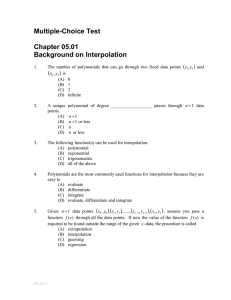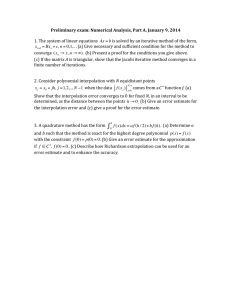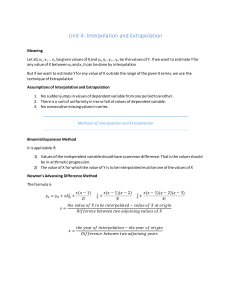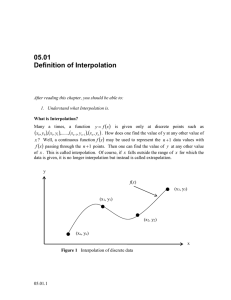ελ ε λ ε σ σ ρ λ λ σ λ σ λ σ ε ε λ λ ε λ ε λ ε σ σ ε ε ρ = σ λ σ λ σ σ λ σ λ σ σ
advertisement
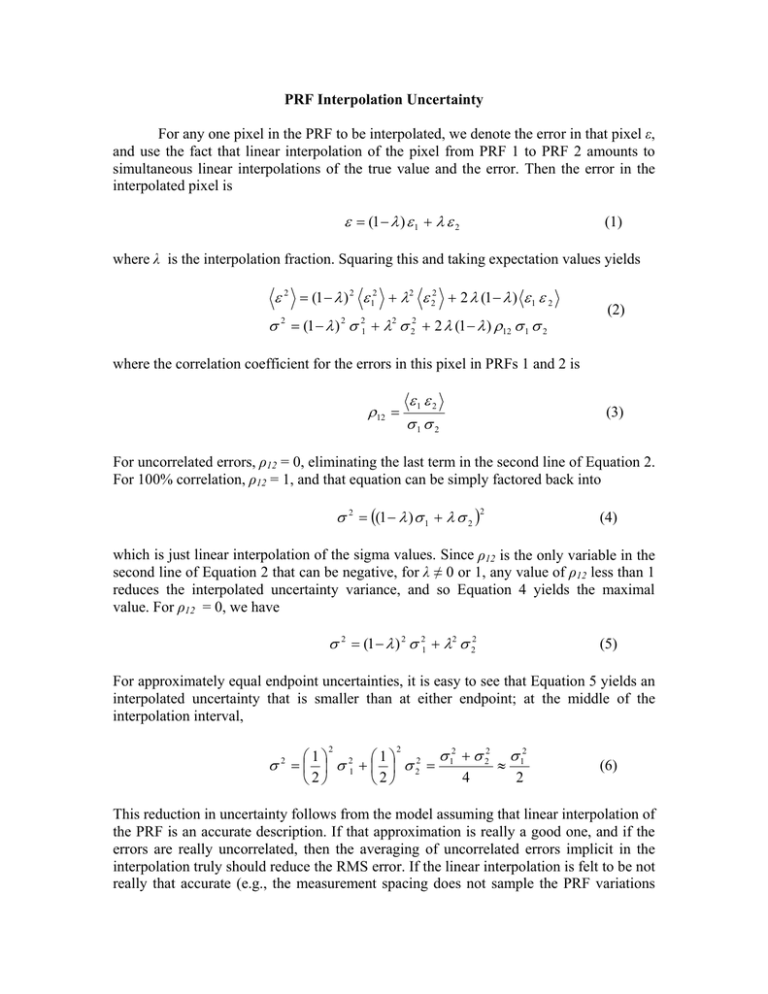
PRF Interpolation Uncertainty For any one pixel in the PRF to be interpolated, we denote the error in that pixel ε, and use the fact that linear interpolation of the pixel from PRF 1 to PRF 2 amounts to simultaneous linear interpolations of the true value and the error. Then the error in the interpolated pixel is ε = (1 − λ ) ε 1 + λ ε 2 (1) where λ is the interpolation fraction. Squaring this and taking expectation values yields ε 2 = (1 − λ ) 2 ε 12 + λ2 ε 22 + 2 λ (1 − λ ) ε 1 ε 2 σ 2 = (1 − λ ) 2 σ 21 + λ2 σ 22 + 2 λ (1 − λ ) ρ12 σ 1 σ 2 (2) where the correlation coefficient for the errors in this pixel in PRFs 1 and 2 is ρ12 = ε1 ε 2 σ1 σ 2 (3) For uncorrelated errors, ρ12 = 0, eliminating the last term in the second line of Equation 2. For 100% correlation, ρ12 = 1, and that equation can be simply factored back into σ 2 = ((1 − λ ) σ 1 + λ σ 2 )2 (4) which is just linear interpolation of the sigma values. Since ρ12 is the only variable in the second line of Equation 2 that can be negative, for λ ≠ 0 or 1, any value of ρ12 less than 1 reduces the interpolated uncertainty variance, and so Equation 4 yields the maximal value. For ρ12 = 0, we have σ 2 = (1 − λ ) 2 σ 21 + λ2 σ 22 (5) For approximately equal endpoint uncertainties, it is easy to see that Equation 5 yields an interpolated uncertainty that is smaller than at either endpoint; at the middle of the interpolation interval, 2 2 σ 2 + σ 22 σ 12 ⎛1⎞ ⎛1⎞ ≈ σ = ⎜ ⎟ σ 21 + ⎜ ⎟ σ 22 = 1 4 2 ⎝2⎠ ⎝2⎠ 2 (6) This reduction in uncertainty follows from the model assuming that linear interpolation of the PRF is an accurate description. If that approximation is really a good one, and if the errors are really uncorrelated, then the averaging of uncorrelated errors implicit in the interpolation truly should reduce the RMS error. If the linear interpolation is felt to be not really that accurate (e.g., the measurement spacing does not sample the PRF variations with negligible error), then some additional uncertainty needs to be added, or possibly just a higher-order interpolation is needed. The linear interpolation of uncertainty variance (as opposed to the quadratic interpolation in Equation 5) may have intuitive appeal, but it lacks a rigorous foundation. Additional uncertainty inside the interpolation interval can be inserted via a random-walk process with just the right growth behavior to produce an overall result equivalent to linear interpolation of variance, but it might seem rather ad hoc. If Equation 5 as it stands seems too optimistic, then probably some random walk process should be added that produces a net increase of uncertainty inside the interpolation region. For example, σ 2 = (1 − λ ) 2 σ 21 + λ2 σ 22 + λ (1 − λ )VRW (7) The choice of VRW = σ12 + σ22 yields linear interpolation of variance. Any larger value yields growth above the linear variance development. The choice of a value could be based on “engineering judgment”. This example shows interpolation from an uncertainty of σ1 = 2 to σ2 = 3, where V1 and V2 are the variances σ12 and σ22, respectively.
